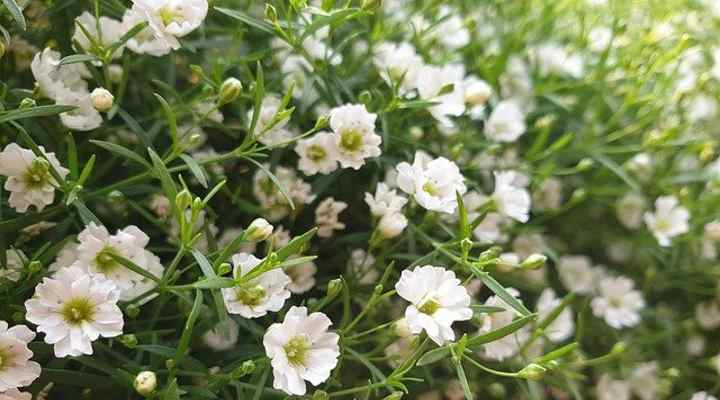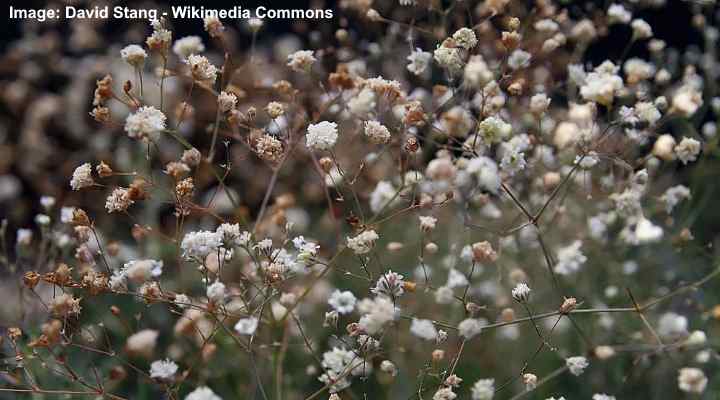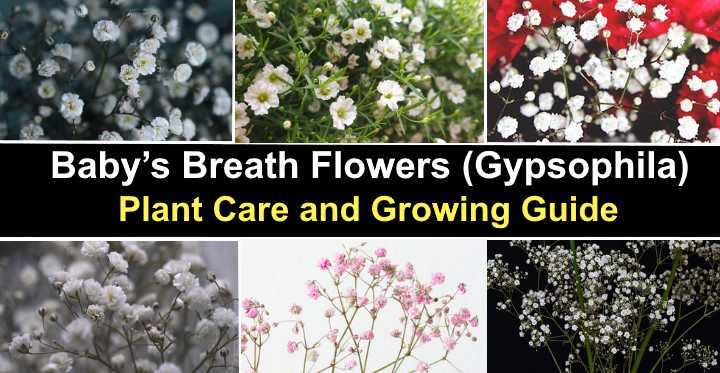Baby’s breath blooms, popular in floral designs and cut flowers, are tiny, delicate white, light pink, or yellow blooms. Airy mounds of little flowers on baby’s breath plants enhance the beauty of a garden landscape, and they bloom as airy mounds. Baby’s breath plants are simple to maintain and return year after year, filling your garden with cheerful cloudscapes of flowers.
This article is a guide to planting and growing baby’s breath flowers in your garden. You’ll also find helpful tips on drying baby’s breath flowers and how to resolve various issues growing this ornamental hardy perennial.
Baby’s Breath Plant (Gypsophila)

Baby’s breath (Gypsophila) is a fast-growing flowering plant with single or double flowers that comes in a variety of colors. The genus Gypsophila encompasses roughly 150 species of annual or hardy perennial plants. Europe, Asia, portions of Africa and Australia are all home to baby’s breath plants.
In gardens, baby’s breath plants create cloud-like mounds of delicate blooms that have a comforting effect. Baby’s breath blooms may grow between 6 inches to 8 feet (15 cm to 2.4 m) tall and up to 4 feet (1.2 m) broad, depending on the species. Creeping plants are ideal for full-sun flowering ground cover plants, and several types of baby’s breath are creeping plants.
Baby’s breath can spread quickly through seeds, forming a vast cloud of white or pink flower clusters with thin stems. is an annual or perennial plant that comes in a variety of forms. Baby’s breath plants fade in the winter. The blooms, however, are prone to self-seeding and may reappear the next year. The roots of perennial baby’s breath are cold-hardy and will bloom year after year, even if the flowers die back to the ground in the fall.
Gypsophila, the botanical name for baby’s breath, alludes to the gypsum-rich environment in which some species thrive. The practice of gifting the flowers during baby showers is said to be the source of the common name “baby’s breath.” Baby’s breath is also said to represent the appealing and innocent appearance of a newborn, according to some.
Baby’s breath flowers are often used to embellish flower displays and arrangements. The large blossoms are enhanced by airy clusters of tiny pink or white blooms. Roses, tulips, gerbera, and other colorful flowers all look great next to the delicate white blooms. In bridal bouquets and floral wedding settings, baby’s breath flowers are also popular.
Baby’s Breath Flowers

Baby’s breath plants are often utilized in floral bouquets and wedding bouquets, and their blossoms create clouds of lovely blooms. Five-petaled single or double blooms form loose clusters called panicles on individual baby’s breath flowers. Between 3″ and 6″ (7.5 – 15 cm) are the diameter of baby’s breath flower heads.
Flowers on the popular annual baby’s breath (Gypsophila elegans) grow up to 2 feet (0.6 meters) tall. Up to 3 feet (1 m) tall, flowering stems of Common Gypsophila (Gypsophila paniculata) Only 8 inches (20 cm) tall on this mat-forming plant, creeping baby’s breath flowers (Gypsophila repens) bloom.
From early summer to late fall, Gypsophila species bloom. The plant blossoms from the third year after sowing baby’s breath seeds.
How to Grow Baby’s Breath Plant and Flowers
In the brightest corner of your garden, plant baby’s breath flowers. Baby’s breath plants are drought tolerant and thrives on dry, well-drained alkaline soils. During prolonged droughts, only water baby’s breath blooms. Baby’s breath thrives in USDA zones 3 through 9 and has a cool, hardy nature.
How to Dry Baby’s Breath – Drying Gypsophila Flower
Dry flower arrangements featuring baby’s breath are perfect. Long-lasting blooms, those on severed stems can last up to 14 days. Drying indoors can help make baby’s breath last longer. Pick stems that are between 12 and 18 inches (30 and 45 cm) long with half of the buds in bloom to dry baby’s breath flowers. Hang upside down in a warm, well-ventilated room with five to seven stems tied together with twine. The baby’s breath should be papery and dry to the touch after five or six days.
How to Grow Baby’s Breath in Your Garden
For growing in front or backyards, Baby’s Breath is an ideal mounding plant. The clusters of flowers flourish well along borders, fill gaps, or serve as a fast-growing ground cover plant in full sun and dry soil. Let’s take a closer look at how to cultivate this lovely blooming hardy perennial in your own garden.
Where to Plant Baby’s Breath
Full sun and well-drained soil are ideal for baby’s breath. For best results, the pH level of the soil should be between 7.0 and 7.5. Once it is established, you don’t need to do much more to keep baby’s breath growing since it is an easy-care flowering garden plant. In gardens, baby’s breath is most often used as a gap filler.
The loose mound of pink, rose, or white blossoms is created by the clumping airy plant. Borders, mixed flower beds, and pots and containers are all good places to grow baby’s breath flowers. With mass plantings, you may also produce lovely ground cover.
When to Plant Baby’s Breath
Late spring, following the last frost date, is the best time to sow baby’s breath seeds or cuttings. Without starting indoors first, baby’s breath will quickly grow from seed. Nonetheless, if you prefer, you may start seeds earlier indoors and transplant once the danger of frost has passed.
How to Grow Baby’s Breath from Cuttings
In your garden, cuttings are the simplest way to grow new baby’s breath plants. Take cuttings from 3″ to 5″ (7.5 cm) long healthy stems. Before transplanting them in your garden, you’ll need to root them indoors. Use your cut stems to remove all leaves from the bottom third portion of your cutting stems in order to create baby’s breath. Place small containers with fertile, alkaline soil at the ends of the stems. To keep the soil moist but not too wet, mist it frequently. Plant the rooted cuttings in your garden after four weeks.
In the brightest portion of your garden, plant the baby’s breath cuttings about 12″ (30 cm) apart. To encourage plant growth, water the ground. You’ll have to make sure the soil is moist but not soggy until the new baby’s breath plants have taken root. Baby’s breath will bloom quicker from cuttings rather than seeds, which is an advantage.
Growing Baby’s Breath from Seeds
Baby’s breath plants may be grown from seed with little difficulty in your garden. You have two options for growing baby’s breath plants from seed: sow immediately in the earth following any frost danger has passed or start indoors. Sow baby’s breath seeds in a sunny area in your garden to encourage them to grow. Sprinkle a thin coating of seeds over the top of the soil. To keep the soil moist, lightly water the ground. When seedlings begin to sprout, trim them down to 12″ (30 cm) intervals.
Seed them in a light, suitable potting mix and begin baby’s breath indoors. Some seed starting formula is included in the cover. Six to eight weeks before you want to move the seedlings in the spring is the ideal time to begin. In 10 to 14 days, seedlings should emerge.
Place the potting trays or pots in a sunny location once baby’s breath seedlings appear. To ensure that the plants get 16 hours of exposure each day, use plant lights. Seedlings are ready to be moved to your garden when the danger of frost has passed and they have at least two pairs of leaves.
Place potted seedlings in a protected spot outdoors before planting them in the ground. The plant hardens as a result of this process. After a week, place 12″ (30 cm) apart in organically rich, alkaline soil the little infant’s breath plants.
Can You Divide Baby’s Breath Plants to Propagate Them?
It’s not recommended to split a baby’s breath plant in order to create additional ones. Digging up an old plant risks destroying the roots and killing it. Use seeds or cuttings rather than root division to reproduce fresh infant’s breath plants. Baby’s breath can spread out as a mounding plant. Baby’s breath is a invasive plant in certain regions. Cutting back on unwanted stems or foliage is the best way to control its growth.
How to Transplant Baby’s Breath Plants
Buying nursery transplants is another way to grow baby’s breath plants in your garden. If you don’t have an existing plant to take cuttings from or don’t want to wait for seeds to sprout, this is an effective way. It’s essential to prepare the soil before transferring rooted nursery baby breath plants. Work in compost or leaf mold until the earth is between 6″ and 12″ (15 – 30 cm) deep. Dig a little hole sufficient enough for the root ball in each pot.
Make sure that the plant’s soil line is level with the ground. Fill in the remaining area with soil, then apply pressure to it. Water the soil thoroughly after you transplant a baby’s breath plant. Next, add 2” (5 cm) of mulch on top. When the top 1″ (2.5 cm) of soil dries out, it waters the newly planted baby’s breath plants. Water the plants weekly unless there is rain until they are established.
Baby’s Breath Care — Light Requirements
When it gets at least six hours of daily sunlight, baby’s breath performs best in full sun. Some partial shade is permissible on particularly hot days. The mounding floral stems, on the other hand, need bright sunlight to thrive. Overly heavy shade stunts blooming and causes leggy development.
The Best Soil for Growing Baby’s Breath
As long as there is excellent drainage, baby’s breath will grow in a wide range of soils. If you want full blooms of white and pink flowers, choose chalky, loamy soil for growing baby’s breath plants. Keep the soil’s pH between 7.0 and 7.5 to produce the best results.
To boost the alkalinity of the ground, you can add lime. Heavy clay soils are the worst kind of soil for growing perennial baby’s breath flowers. Baby’s breath plants in a raised flower bed are a good choice if your garden has this type of ground. You may alternatively cultivate baby’s breath on your balcony, patio, or deck by using pots or containers.
How to Water Baby’s Breath Plants
Baby’s breath is a little water-efficient flowering plant that requires little water. It requires little care and thrives on dry soil. To keep the soil moist during the summer, you may need to water it once a week or less. The enormous fleshy roots rot, killing the plant when too much water is given to baby’s breath. When planting young baby’s breath seedlings or cuttings, be careful. Until the plant establishes itself, the area should be moist to moderate.
Temperature and Humidity Growing Baby’s Breath in Gardens
Baby’s breath thrives in USDA zones 3 to 9, with the exception of a few species. The stems of plants in chilly places may die back to the earth. Check the minimal growing zone and whether it’s an annual or perennial variety before planting a baby’s breath plant in your garden. Baby’s breath plants prefer to grow in arid environments. It is vital that the ground drains well if you live in a humid environment. If you don’t treat your mounding garden plant with fungicide, it may experience fungal leaf damage.
Pruning Baby’s Breath
Pruning is not necessary for Baby’s breath. To keep the bushy flowering mound looking its best, all you have to do is prune long, leggy stems. You can deadhead the terminal flowers when they start to die in order to encourage blooming throughout the summer. Trimming back the stems to the point where the secondary sprays begin to appear is ideal.
This technique of pruning helps flowers survive until autumn. You may cut back baby’s breath stems to about 1″ (2.5 cm) above the ground after the secondary blooming has finished. To protect roots from frost, cover the root base with a layer of mulch. The following spring, new stems should sprout.
Is Baby’s Breath Toxic?
Inhaled by animals and people, baby’s breath plants may be mildly harmful. Gypsophila paniculata is a poisonous plant that causes dermatitis, itching, and skin discomfort, according to the University of California. Always wear protective gloves when trimming a infant’s breath plant because the sap can irritate your skin.
How to Resolve Issues Growing Baby’s Breath in Your Yard
Baby’s breath is a tough, healthy plant that fights against pests and diseases. Gypsophila species seldom experience growing issues when they grow in arid soil and get plenty of sunlight. However, there are a few things to keep in mind before you start planting. Baby’s breath foliage can be infested by leafhoppers and aphids.
These annoying little green bugs suck plant sap, which causes distorted or colored foliage. Young baby’s breath plants are often attacked by leafhoppers. Therefore, in the first month following planting in your garden, try covering them with row covers to protect them in spring.
Fungal infections may be caused by excess soil moisture, wet leaves, or poor air circulation. Thinning the plant to improve air circulation may help you identify dusty gray mold on foliage. Also, make sure not to splash water on the lower leaves while watering.
The stems of infected plants frequently turn mushy and release a unpleasant stench. Keep the soil as dry as possible and only water it occasionally to avoid roots from decaying. Leaving a 2″ (5 cm) radius of mulch-free ground around the main stems is also essential. This helps ensure that roots do not succumb to moisture.
Varieties of Baby’s Breath
The following are a few varieties of baby’s breath:
Gypsophila elegans—The large, open blooms of this annual baby breath plant are embellished with lovely white flowers. Bouquets and flower arrangements often include this baby’s breath species.

Gypsophila repens— A mat of foliage and flowers develops on this creeping baby’s breath plant. Rock gardens and ground cover are ideal for it.

Gypsophila paniculata—Because of its lovely airy panicles, the Common Gypsophila is another popular flower for floral displays. A perennial baby’s-breath with a lot of little flowers.

Gypsophila paniculata ‘Bristol Fairy’—Little, delicate double white blooms 0.25″ (0.5 cm in diameter) adorn the baby’s breath plant. It has a mound shape and grows to be 3 feet (1 meter) tall.

Gypsophila paniculata ‘Festival Star’—USDA zone 3 is an ideal location for growing this hardy baby’s breath variety. Its most outstanding characteristic is the clusters of stunning white blooms on 1-foot (30-cm) tall stems.

Gypsophila paniculata ‘Viette’s Dwarf’—This mound-forming plant grows 12 to 15 inches (30 to 38 cm) tall and is a cultivar of the baby’s breath. Double pink blooms growing in airy clusters are its appealing feature.

‘Viette’s Dwarf’ Gypsophila paniculata
